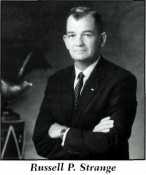|
Lawmakers celebrate historical markers
At the beginning of March, State Representative and Deputy Majority Leader Arthur L. Turner (D, 9th District) introduced the following resolution into the record at the Illinois Statehouse in Springfield, thereby officially beginning the Society's 3rd annual "Historical Markers Awareness Week" celebration. Nine marker dedications are planned for the spring (see page 7).
House Resolution #127
WHEREAS, Many places in Illinois are significant sites of local, state, national and world history; and
WHEREAS, Visitors to these sites learn about historic people, ideas and developments there; and
WHEREAS, Such visits deepen our interest in, and appreciation of, history; and
WHEREAS, History help us understand our place in the world and how we might improve it; and
WHEREAS, increasing visitations at historic sites stimulates beautification, preservation, conservation, tourism and business in Illinois communities and counties where they are located; and
WHEREAS, The Illinois State Historical Society, recognized by the Illinois General Assembly in 1903 as a major contributor to the awareness and appreciation of history in Illinois, has already placed its markers at more than four hundred historic sites around the State; and
WHEREAS, The Illinois General Assembly and The Illinois State Historical Society it recognized now seek to heighten historical awareness in Illinois residents and visitors by calling attention to these markers and historic sites throughout the State;
RESOLVED, RY THE HOUSE OF REPRESENTATIVES OF THE NINETY-FOURTH GENERAL ASSEMBLY OF THE STATE OF ILLINOIS, THE SENATE CONCURRING HEREIN, That the week of February 25 through March 2 in 2007 shall be known as Illinois State Historical Society Marker Awareness Week with a special State ceremony in Springfield on March 2;
And be it further
RESOLVED, That all Illinois residents and visitors are encouraged to celebrate this week by learning about historic sites in their locales, visiting them, reflecting on their importance in history, communicating with others about them, and attending ceremonies commemorating them;
And be it further
RESOLVED, That Illinois State Representatives are encouraged to participate in the events of this week with their colleagues in the Capitol and their constituents in their home districts.
Evanston author wins Society's first Russell P. Strange Book Award
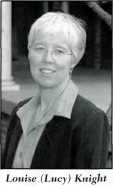 Louise (Lucy) W. Knight received the Society's first annual Russell P. Strange Memorial Book Award for her 2005 biography of Jane Addams on February 16 at the 27th Annual Illinois History Symposium. The award was presented at the symposium banquet, held at Illinois State University's Bone Student Center Ballroom. The 2007 recipient of this prestigious award is a Chicago-area native, currently living in Evanston. The award honors an outstanding achievement by a living author writing about a topic in Illinois history. Louise (Lucy) W. Knight received the Society's first annual Russell P. Strange Memorial Book Award for her 2005 biography of Jane Addams on February 16 at the 27th Annual Illinois History Symposium. The award was presented at the symposium banquet, held at Illinois State University's Bone Student Center Ballroom. The 2007 recipient of this prestigious award is a Chicago-area native, currently living in Evanston. The award honors an outstanding achievement by a living author writing about a topic in Illinois history.
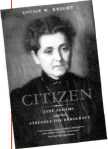 Knight's book, Citizen: Jane Addams and the Struggle for Democracy (Univ. of Chicago Press), focuses on the first half of Addams's life, from her childhood in rural northern Illinois in the 1860s to her founding of Chicago's Hull House and activism for democracy and women's rights at the end of the 19th century. Knight is an independent scholar, author, and consultant, has taught rhetoric at Northwestern University. Her articles on Jane Addams have appeared in Journal of Women's History and Gender and History. Knight's book, Citizen: Jane Addams and the Struggle for Democracy (Univ. of Chicago Press), focuses on the first half of Addams's life, from her childhood in rural northern Illinois in the 1860s to her founding of Chicago's Hull House and activism for democracy and women's rights at the end of the 19th century. Knight is an independent scholar, author, and consultant, has taught rhetoric at Northwestern University. Her articles on Jane Addams have appeared in Journal of Women's History and Gender and History.
The award is named for Colonel Russell P. Strange, a former vice president of the Society and a lifelong student of history. Col. Strange had an illustrious career as head of the University of Illinois's Air Force ROTC unit and chair of Eastern Illinois University's political science department, his position at the time of his death in 1966.
The award was established by Priscilla J. Matthews, daughter of Colonel Strange. Ms. Matthews is Senior Cataloging Librarian at Milner Library and a member of the library faculty at Illinois State University.
ILLINOIS HERITAGE 4
 Illinois libraries to host "Forever Free: Abraham Lincoln's Journey to Emancipation" Illinois libraries to host "Forever Free: Abraham Lincoln's Journey to Emancipation"
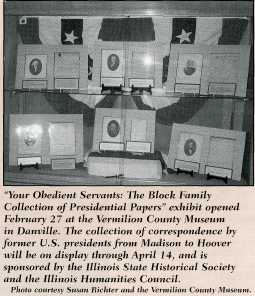 Sixty-three libraries—including six in Illinois— have been selected to host a new tour of "Forever Free: Abraham Lincoln's Journey to Emancipation," an exhibit which reexamines President Lincoln's thoughts about slavery throughout his political career and the conditions which led to the Emancipation Proclamation. The American Library Association (ALA) Public Programs Office (PPO) and The Huntington Library, San Marino, California, organized the exhibit with grants from the National Endowment for the Humanities (NEH) and the Abraham Lincoln Bicentennial Commission, Washington, D.C. The Gilder Lehrman Institute of American History, New York, provided additional support. Sixty-three libraries—including six in Illinois— have been selected to host a new tour of "Forever Free: Abraham Lincoln's Journey to Emancipation," an exhibit which reexamines President Lincoln's thoughts about slavery throughout his political career and the conditions which led to the Emancipation Proclamation. The American Library Association (ALA) Public Programs Office (PPO) and The Huntington Library, San Marino, California, organized the exhibit with grants from the National Endowment for the Humanities (NEH) and the Abraham Lincoln Bicentennial Commission, Washington, D.C. The Gilder Lehrman Institute of American History, New York, provided additional support.
Developed by The Huntington Library's John Rhodehamel, Norris Foundation Curator of American Historical Manuscripts, the exhibit consists of reproductions of rare historical documents and photographs from the Huntington, the Gilder Lehrman Institute, and other collections, and a text that draws on the latest scholarship in the field.
The libraries selected for the new tour will host the exhibit for a six-week period from April 2007 through October 2011. Libraries will make the exhibit available for public viewing and host a number of educational programs and receptions to increase the public's understanding of the exhibit and its themes. All showings of the exhibition and related programs will be free and open to the public."This exhibit provides libraries with many excellent programming themes that will help audiences to understand the process Lincoln went through in deciding to support the abolition of slavery," said David Zeidberg, director of the Huntington Library. "We are pleased to be able to offer the project to another 63 libraries representing 31 states."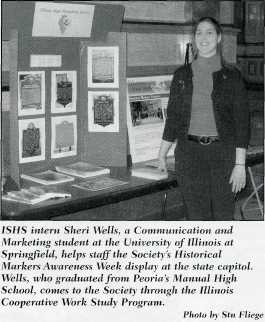 The libraries selected for the new tour are (in alphabetical order by community):
Lovejoy Library, Southern Illinois University/Edwardsville (Oct. 18-Nov. 30, '07)
Gail Borden Public Library District, Elgin (April 17-May 30, 2008)
Frankfort Public Library District, Frankfort (April 28-June 10, 2011)
Freeport Public Library, Freeport (June 28-Aug. 10, 2007)
Milner Library, Illinois State University, Normal (Aug 23-Oct 5, 2007)
Rockford Public Library, Rockford (April 17-May 30, 2008) To see the complete tour itinerary, please visit www.ala.org/publicprograms/lincoln.
ILLINOIS HERITAGE 5
 American History 101 American History 101 So you think you know American history? Answer this not-so-simple simple question: Who was America's first president? If—as do 95 percent of other red, white, and blue Americans—you answered, "George Washington,' you'd be wrong. Here's why. The Declaration of Independence was signed in July 1776 (we won't quibble about the date, although it wasn't July 4th), but the Constitution of the United States of America was not ratified until 1787. George Washington was not elected President until 1789. From 1776 until 1781, when Cornwallis surrendered at Yorktown, Washington led the American armies in the Revolution, but he was not leading the country as its commander in chief. That task fell to the Continental Congress, which on March 1, 1781, adopted the Articles of Confederation, the nation's first official constitution.  Once the Articles of Confederation were signed, a president was needed to "preside" over the Congress of the United States. The Congress — including George Washington — unanimously chose John Hanson of Maryland, who served in that office from November 5, 1781 until November 3, 1782. Hanson was the first American President to serve a full term in office and accomplished several important things, including establishing the nation's first Treasury and Foreign Affairs departments, and paying American troops who had fought in the Revolution. He also held the country together when angry Revolutionary soldiers threatened to bring down the government and install Washington as a monarch. Once the Articles of Confederation were signed, a president was needed to "preside" over the Congress of the United States. The Congress — including George Washington — unanimously chose John Hanson of Maryland, who served in that office from November 5, 1781 until November 3, 1782. Hanson was the first American President to serve a full term in office and accomplished several important things, including establishing the nation's first Treasury and Foreign Affairs departments, and paying American troops who had fought in the Revolution. He also held the country together when angry Revolutionary soldiers threatened to bring down the government and install Washington as a monarch.
Hanson was succeeded by six other American Presidents before Washington took office: Elias Boudinot (1783); Thomas Mifflin (1784); Richard Henry Lee (1785), Nathan Gorman (1786); Arthur St. Clair (1787), and Cyrus Griffin (1788). So why don't we ever hear about the first seven American Presidents? The Articles of Confederation, written when the Founding Fathers were deciding whether to be a sovereign nation or a loose confederation of independent states, did not give the national government enough power to enforce its own laws. Individual states had the power to levy taxes, impose tariffs, and to raise an army, but the federal government did not. These self-imposed restrictions nearly had disastrous effects during Shays' Rebellion in 1786. A new Constitution was drafted, this one empowering the federal government to hold far tighter reins on the fledgling democracy. It was under this new constitution that George Washington was elected President, and his seven predecessors were subsequently lost to history. John Hanson was the first American President and deserves to be remembered. —William Furry
ILLINOIS HERITAGE 6
 Society plans spring marker dedications Society plans spring marker dedications The ISHS Historical Markers Committee has announced that several new and refurbished historical markers will be unveiled this spring. Stu Fliege, chair of the markers committee, released the names of 8 new markers and one restored marker that will be dedicated in coming weeks, including: ■ Earl C. Smith, Agricultural Leader marker, to be dedicated March 23 in Detroit, Illinois. Earl C. Smith of Pike County was president of the Illinois Agricultural Association/Illinois Farm Bureau, and later served as vice president of the American Farm Bureau Federation. His work and leadership brought relief to American farmers through the first and second terms of President Franklin Roosevelt. Co-sponsored by the Illinois Farm Bureau and the County Farm Bureaus in Illinois. ■ Senator John Humphrey Home, Orland Park, to be dedicated at 9 a.m. on Saturday, May 12. Senator Humphrey was elected to the Illinois House of Representatives (1880 and 1884) and served in the Illinois Senate from 1886-1910. His home, the second oldest in Orland Park, was built in 1881 and placed on the National Register in 2005. Co-sponsored by the Orland Historical Society. ■ Reservoir Park/Lanphier High School marker, Springfield, to be dedicated in mid-April. Reservoir Park was Springfield's municipal water source from the late 1800s until the building of Lake Springfield in the 1930s. The site was purchased by the Springfield School District, which constructed Lanphier High School there in 1935. The school was named for Robert C. Lanphier, a local industrialist. Co-sponsored by the Lan-Hi Yearbook Staff.
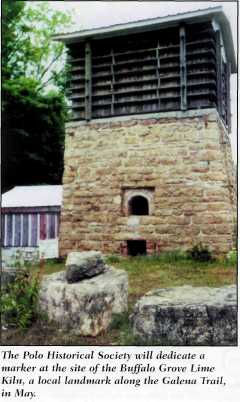 ■ Buffalo Grove Lime Kiln, near Polo, to be dedicated in May, recognizes an important local landmark along the Galena Trail. The Buffalo Grove Lime Kiln operated from 1870-1915 and provided mortar for buildings throughout the region. The free-standing kiln was restoredto functional condition in 1993 and placed on the National Register of Historic Places in 2002. Cosponsored by the Polo Historical Society. ■ Buffalo Grove Lime Kiln, near Polo, to be dedicated in May, recognizes an important local landmark along the Galena Trail. The Buffalo Grove Lime Kiln operated from 1870-1915 and provided mortar for buildings throughout the region. The free-standing kiln was restoredto functional condition in 1993 and placed on the National Register of Historic Places in 2002. Cosponsored by the Polo Historical Society.
■ Two George Rogers Clark encampment markers will be dedicated in mid April in southern Illinois, each to commemorate campsites established by Lieutenant Colonel Clark and his army of Virginians while on their way to liberate Kaskaskia from British occupancy in 1778 during the American Revolution. The markers will be erected near the communities of Breven and Ava, and are sponsored by Bowman's Company, a reactivated Revolutionary War heritage unit.
■ The Illinois Watch Case Company in Elgin, a leader in domestic watch production for more than 70 years, will be remembered with a marker in mid May. Sponsored by the Elgin Heritage Commission, the marker celebrates the company's long production history (30 million watch cases) and highlights its contribution to the American forces in World War II.
■ During the 2007 Annual Meeting, the Society, along with the Great Alton Chamber of Commerce, will redediated the Lincoln-Douglas Debate marker on the plaza in downtown Alton. The original marker disappeared several years ago, possibly during reconstruction of the plaza, and has recently been reworded and cast. The new marker also corrects the date of the debate, which was held on October 15, 1858. The dedication is scheduled for 11 a.m., Saturday, April 28.
■ The Piasa Bird historical marker, also missing for several years, was recently recovered and repainted, and will be remounted near its original location prior to the Annual Meeting. The Illinois Department of Transportation was instrumental in cleaning up the marker and getting it back in the ground. For more information about times and locations for these marker dedications, call 217-525-2781. ILLINOIS HERITAGE 7
Illinois Periodicals Online (IPO) is a digital imaging project at the
Northern Illinois University Libraries funded by the Illinois State Library
|
|


